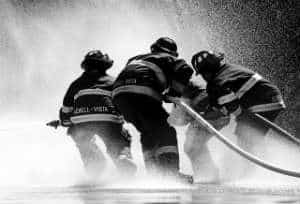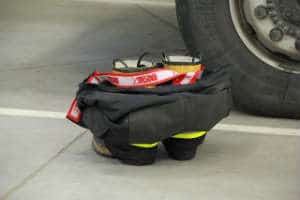Workplace Slip And Fall Dangers: Firefighters

Ladders
One of the more dangerous parts of fighting a fire in bad weather is climbing aluminum ladders. While the steps of new ladders have traction devices that work well in good weather, these ladders can still become dangerous when it is snowing or raining out. To help firefighters stay on their feet and offer protection from slipping, many communities have installed slip guards on ladders that do not already have a coating of traction material on their steps.
These slip guards can be easy to install, and they can make a big difference between a firefighter able to do his job and a firefighter injured in the line of duty. Other options include purchasing a spray material that offers a thin coating of traction in all types of weather.
Boots
Another problem firefighters experience when it comes to slip and fall accidents at a fire scene is the boot being used. Most fire companies prefer rubber boots because they are often hundreds of dollars per pair less than leather boots. In some cases, the difference can be as much as $200 per pair. But when all of the numbers are taken into account, buying leather boots for firefighters makes a lot of sense.
Leather boots offer better protection from fires and better traction in bad weather. It is estimated that one firefighter injury can cost a fire company Around $41,000 in losses. In an average fire company with 500 firefighters, it is estimated that six of those firefighters are injured every year from slip and fall accidents. Leather boots last for years, and the economics suggests that buying leather boots is a smart financial move for fire companies.
Making The Work Site Safer
Fire companies that work in cold weather climates have developed an effective way to reduce slip and fall accidents on icy concrete surfaces and roads. Most companies carry sand or rock salt with them to spread around the fire scene to prevent the build-up of ice in high traffic areas. This includes the sidewalks and roads of fire scenes that have been covered in water that has turned to ice. Not only does this make the scene safer for the firefighters, but it also makes driving and walking safer for the public when the firefighters leave.
Can Firefighters Sue?
Throughout the country, there has been something in effect for a long time now called “The Fireman’s Rule.” Under this rule, firefighters agree that they assume all responsibility when they go to a fire call because of their compensation and benefits packages. When a firefighter slips and falls at a fire scene, they cannot sue the property owner.
In some states, such as New York, the fireman’s rule has been eliminated and has cleared the way for firefighters and police officers to sue if they are injured on the job. However, the plaintiff needs to be very sure of their evidence when they do sue because a lawsuit found to have no basis, in fact, could cost the firefighter their job.
In Pennsylvania, the fireman’s rule is in effect but not always honored. In some cases, state courts in Pennsylvania have allowed firefighters to sue property owners if the firefighter has been injured due to property owner negligence.
Firefighters face many risks when doing their jobs, and a slip and fall accident is one of those risks. With the right equipment, fire companies can reduce slip and fall accidents and prevent firefighters from getting injured while performing their dangerous duties.
